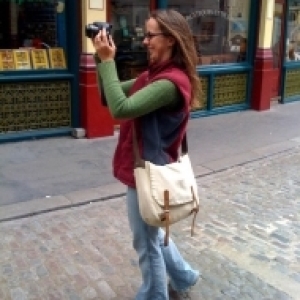Heroic deeds of the people
Fred navigated a secret London walk that visited Postman's Park, near St Paul's Cathedral. At one end of the garden is a tiled wall, and on each of the tiles is a description of a heroic deed in which the hero perished. There are burning buildings, speeding trains, drownings... and many involve children, both as victims and heroes. To either side of each tile are beautiful illustrations and patterns, picking out details of the hero's profession or type of heroic deed. The gentleman on this plaque is the latest to have been added to the wall, and the most recent since 1929. I found out more by listening to this radio programme.
The walk continued to St Bartholomew-the-Great, a Norman church, part of which used to be the workplace of Benjamin Franklin, one of the founding fathers of the US. It's an atmospheric, quiet church, tucked down an alleyway that's fronted by a Tudor house and a 13th-century gateway.
Near the church, I spied a telephone box that was covered with notes about Sherlock Holmes. We puzzled over it for a while until a young lady sitting on a bench nearby came over and explained that Sherlock died right here after falling from the building above us (in the TV series, that is). She was a big fan and was making a pilgrimage to the scene. She showed us a text on her phone that she'd written to a friend: "I'm with some people who don't actually know what this is."
Earlier in the day, we viewed Cotman in Normandy, which is a wonderful exhibition of architectural watercolours. There are one or two of Cotman's contemporary, Turner, too, although I far preferred the Cotman watercolours. The juxtaposition of precise draughtsmanship and gentle colours of the countryside work so well.

Comments
Sign in or get an account to comment.


